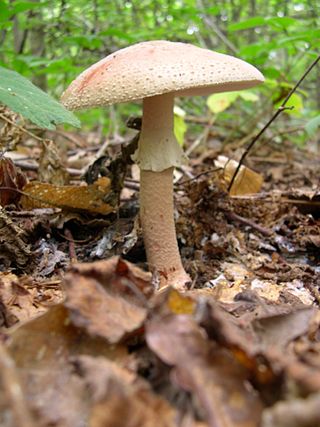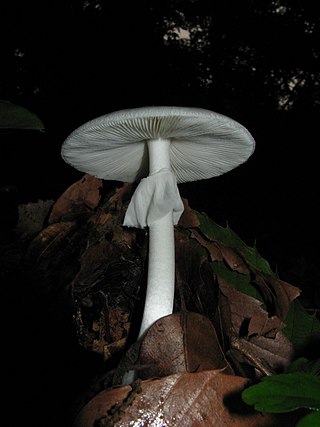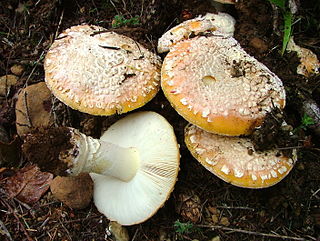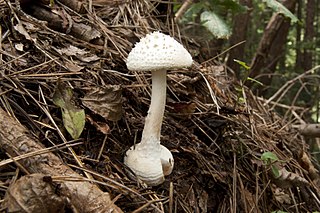
The name destroying angel applies to several similar, closely related species of deadly all-white mushrooms in the genus Amanita. They are Amanita virosa in Europe and A. bisporigera and A. ocreata in eastern and western North America, respectively. Another European species of Amanita referred to as the destroying angel, Amanita verna - also referred to as the 'Fool's mushroom' - was first described in France in 1780.

The genus Amanita contains about 600 species of agarics, including some of the most toxic known mushrooms found worldwide, as well as some well-regarded edible species. The genus is responsible for approximately 95% of fatalities resulting from mushroom poisoning, with the death cap accounting for about 50% on its own. The most potent toxin present in these mushrooms is α-Amanitin.

Amanita virosa, commonly known in Europe as the destroying angel or the European destroying angel amanita, is a deadly poisonous basidiomycete fungus, one of many in the genus Amanita. Occurring in Europe, A. virosa associates with various deciduous and coniferous trees. The large fruiting bodies appear in summer and autumn; the caps, stipes and gills are all white in colour.

The Amanitaceae is a family of mushroom-forming fungi. Amanita Pers. is one of the most speciose and best-known fungal genera. The family, also commonly called the amanita family, is in order Agaricales, the gilled mushrooms. The family consists primarily of the large genus Amanita, but also includes the smaller genera Amarrendia, Catatrama, Limacella, Limacellopsis, Saproamanita, Torrendia and Zhuliangomyces. Both Amarrendia and Torrendia are considered to be synonymous with Amanita but appear quite different because they are secotioid.

The blusher is the common name for several closely related species of the genus Amanita. A. rubescens, or the blushing amanita, is found in Europe and eastern North America, and A. novinupta, also known as the new bride blushing amanita, is found in western North America. Both their scientific and common names are derived from the propensity of their flesh to turn pink upon bruising or cutting.

Amanita calyptroderma also known as coccora, coccoli or the Pacific amanita, is a white-spored mushroom that fruits naturally in the coastal forests of the western United States during the fall and winter and spring.

Amanita verna, commonly known as the fool's mushroom or the spring destroying angel, is a deadly poisonous basidiomycete fungus, one of many in the genus Amanita. Occurring in Europe in spring, A. verna associates with various deciduous and coniferous trees. The caps, stipes and gills are all white in colour.

Agaricus campestris is a widely eaten gilled mushroom closely related to the cultivated A. bisporus. A. campestris is commonly known as the field mushroom or, in North America, meadow mushroom.

Amanita ocreata, commonly known as the death angel, destroying angel, angel of death or more precisely western North American destroying angel, is a deadly poisonous basidiomycete fungus, one of many in the genus Amanita. The large fruiting bodies generally appear in spring; the cap may be white or ochre and often develops a brownish centre, while the stipe, ring, gill and volva are all white. A. ocreata resemble several edible species commonly consumed by humans, increasing the risk of accidental poisoning. Mature fruiting bodies can be confused with the edible A. velosa, A. lanei or Volvopluteus gloiocephalus, while immature specimens may be difficult to distinguish from edible Agaricus mushrooms or puffballs.

Amanita flavoconia, commonly known as yellow patches, yellow wart, orange amanita, yellow-dust amanita or the American yellow dust amanita, is a species of mushroom in the family Amanitaceae. It has an orangish-yellow cap with yellowish-orange patches or warts, a yellowish-orange annulus, and a white to orange stem. Common and widespread throughout eastern North America, A. flavoconia grows on the ground in broad-leaved and mixed forests, especially in mycorrhizal association with hemlock.

Amanita bisporigera is a deadly poisonous species of fungus in the family Amanitaceae. It is commonly known as the eastern destroying angel amanita, the eastern North American destroying angel or just as the destroying angel, although the fungus shares this latter name with three other lethal white Amanita species, A. ocreata, A. verna and A. virosa. The mushroom has a smooth white cap that can reach up to 10 centimetres across and a stipe up to 14 cm tall with a white skirt-like ring near the top. The bulbous stipe base is covered with a membranous sac-like volva. The white gills are free from attachment to the stalk and crowded closely together. As the species name suggests, A. bisporigera typically bears two spores on the basidia, although this characteristic is not immutable. A. bisporigera closely resembles a few other white amanitas, including the equally deadly A. virosa and A. verna.
Amanita virosiformis, commonly known as the narrow-spored destroying angel, is a poisonous basidiomycete fungus, one of many in the genus Amanita. Originally described from Florida, it is found from coastal North Carolina through to eastern Texas in the southeastern United States.
Amanita elliptosperma, commonly known as the Atkinson's destroying angel, is a basidiomycete fungus, one of many in the genus Amanita. Although its toxicity is not confirmed, it is assumed to be deadly poisonous like its close relatives. Originally described from North Carolina, it is found in the eastern United States from New England to eastern Texas.

Amanita aprica, also known as the sunshine amanita, is a toxic species of fungus in the family Amanitaceae.

Amanita sphaerobulbosa, commonly known as the Asian abrupt-bulbed Lepidella, is a species of agaric fungus in the family Amanitaceae. First described by mycologist Tsuguo Hongo in 1969, it is found in Southern Asia.
Amanita pallidorosea is a mushroom of the large genus Amanita, which occurs under beech and pine in China and Japan. It is closely related to the destroying angel A. bisporiga.
Amanita subpallidorosea is a mushroom of the large genus Amanita, which occurs under oaks in southern China and Taiwan.

Amanita crenulata, also known as the poison champagne amanita, is a species of fungus that is very common in the Northeast United States.
Amanita hygroscopia, also known as the pink-gilled destroying angel is a deadly poisonous fungus, one of many in the genus Amanita.
















